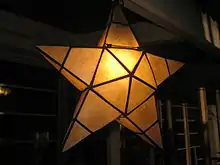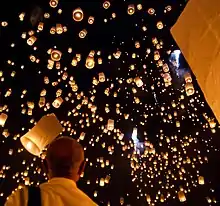Paper lantern
A paper lantern is a lantern made of thin, brightly colored paper.[1] Paper lanterns come in various shapes and sizes, as well as various methods of construction. In their simplest form, they are simply a paper bag with a candle placed inside, although more complicated lanterns consist of a collapsible bamboo or metal frame of hoops covered with tough paper.

Origin
Paper lanterns are likely derived from earlier lanterns that used other types of translucent material like silk, horn, or animal skin. The material covering was used to prevent the flame in the lantern from being extinguished by wind, while still retaining its use as a light source. Papermarking technology originated from China from at least AD 105 during the Eastern Han Dynasty,[2][3] but it is unknown exactly when paper became used for lanterns. Poems about paper lanterns start to appear in Chinese history at around the 6th century. [2] Paper lanterns were common by the Tang Dynasty (AD 690–705), and it was during this period that the first annual lantern festival was established.[2] From China, it was spread to neighboring cultures in East Asia, Southeast Asia, and South Asia.
Types
There are three general types of paper lanterns, they are:
- Hanging lantern - the basic type of paper lantern used for illumination. They are meant to be carried, hung, or mounted on stands.
- Sky lantern - a small hot air balloon made of paper, with an opening at the bottom where a small fire is suspended. Also known as "flying lanterns", "sky candles" or "fire balloons."
- Water lantern - paper lanterns that float on the surface of water.
By Region
In addition to everyday usage as a light source in the past, paper lanterns are commonly associated with festivals in East Asian, Southeast Asian, and South Asian cultures.
China & Taiwan
Paper lanterns are called Dēnglóng (simplified Chinese: 灯笼; traditional Chinese: 燈籠) in China.
 Lantern festival at the Chiang Kai-shek Memorial Hall in Taiwan
Lantern festival at the Chiang Kai-shek Memorial Hall in Taiwan
Japan
In Japan the traditional styles include bonbori and chōchin and there is a special style of lettering called chōchin moji used to write on them.
 A chochin lantern from Japan
A chochin lantern from Japan Hexagonal bonbori lamps the Ise Grand Shrine
Hexagonal bonbori lamps the Ise Grand Shrine
Philippines
In the Philippines, a traditional paper lantern is the parol, which is regarded an iconic symbol of Filipino Christmas. Traditionally constructed using bamboo and Japanese paper, modern parols have been made using other materials such as plastic, metal, and capiz shells. Its most-common form is a five-pointed star, although it can come in various shapes and sizes.[4][5][6]
Dating back to the Spanish colonial period of the Philippines, parols are a traditional part of the Panunulúyan pageant in the nine-day Christmas Novena procession leading up to the Simbang Gabi (midnight mass). It was initially rectangular or oblong in shape but eventually came to be made in various shapes. It became standardized to a five-pointed star (symbolizing the Star of Bethlehem) during the American colonial period.[7]
 A simple star-shaped parol made of capiz shells
A simple star-shaped parol made of capiz shells Parols for sale
Parols for sale Programed electronic parols during the 2012 Giant Lantern Festival in San Fernando, Pampanga
Programed electronic parols during the 2012 Giant Lantern Festival in San Fernando, Pampanga
Thailand
During the Yi Peng festival of Thailand, some people also decorate their houses, gardens, and temples with khom fai (Thai: โคมไฟ), intricately shaped paper lanterns which take on different forms. Khom thue (Thai: โคมถือ) are lanterns which are carried around hanging from a stick, khom khwaen (Thai: โคมแขวน) are the hanging lanterns, and khom pariwat (Thai: โคมปริวรรต), which are placed at temples and which revolve due to the heat of the candle inside. The most elaborate Yi Peng celebrations can be seen in Chiang Mai,[8] the ancient capital of the former Lanna kingdom, where now both Loi Krathong and Yi Peng are celebrated at the same time resulting in lights floating on the waters, lights hanging from trees/buildings or standing on walls, and lights floating in the sky. The tradition of Yi Peng was also adopted by certain parts of Laos during the 16th century.
Thousands of sky lanterns called khom loi (Thai: โคมลอย) are also released annually during the Yi Peng festival. However, this is a relatively new addition to the festival, only dating back to the first decade of the 21st century as part of tourism development.[9]
 Sky lanterns in the sky on the night of Yi Peng in Thailand.
Sky lanterns in the sky on the night of Yi Peng in Thailand.
Sri Lanka
Colorful paper lanterns called vesak kuudu are hung outside houses during the Buddhist festival of Vesak.[10]
 Traditional Vesak lanterns during Vesak in Sri Lanka
Traditional Vesak lanterns during Vesak in Sri Lanka
United States
Placing candles or tea lights in a succession of small paper bags (known as luminarias or farolitos) is a common Christmas tradition in New Mexico. The tradition originated from the parol paper lanterns of the Philippines brought over to the Americas during the colonial period.[11][12][13][14]
 Luminarias during Christmas in Albuquerque, New Mexico
Luminarias during Christmas in Albuquerque, New Mexico
Europe
During the Festa della Rificolona held in Florence, Italy, children carry colourful paper lanterns through the streets of the city.
In Germany, Austria, Switzerland and other German-speaking and some Dutch-speaking parts of Europe there is a tradition of the Sankt-Martins-Umzug (Sint-Maarten in Dutch), during which children parade with paper lanterns that are traditionally handmade.
The Way to Make
- Make the skeleton. Paper lanterns[15] are easier to make in the shape of a cube or cylinder. Use bendable bamboo sticks or bamboo bark to form the frame, and then tie it tightly with thin thread. If you can't find bamboo sticks, you can also use cardboard.
- Cut plain white or red rice paper or golden rice paper to the length and width of the lantern skeleton, and then you can design your own pattern. Calligraphy, painting, and paper cutting can all be displayed on the small lanterns.
- Make the light source. If the lantern needs to be kept indoors, simply light an ordinary candle in the lantern. If you want to take it out, you can use a candle-shaped electric bulb.
In photography
High-wattage paper lanterns are commonly used in lighting for motion picture productions. Commonly referred to as "China balls", they provide soft, edgeless light to a scene.[16]
References
- "Chinese lantern". The Free Dictionary. Retrieved 18 May 2014.
- Tsien, Tsuen-Hsuin (1985). "Chemistry and Chemical Technology, Part 1: Paper and Printing". In Needham, Joseph (ed.). Science and Civilisation in China. Vol. 5. Cambridge University Press. p. 128. ISBN 0521086906.
- Hogben, Lancelot. "Printing, Paper and Playing Cards". Bennett, Paul A. (ed.) Books and Printing: A Treasury for Typophiles. New York: The World Publishing Company, 1951. pp. 15–31. p. 17. & Mann, George. Print: A Manual for Librarians and Students Describing in Detail the History, Methods, and Applications of Printing and Paper Making. London: Grafton & Co., 1952. p. 77
- J., John (2005). A Christmas Compendium. Continuum International Publishing Group. p. 67. ISBN 0-8264-8749-1. Retrieved December 20, 2007.
- Magocsi, Paul R. (2006). Encyclopedia of Canada's Peoples. University of Toronto Press (published 1999). p. 510. ISBN 0-8020-2938-8. Retrieved December 20, 2007.
- "Christmas decors, Filipino-style" (in Tagalog). GMA news.TV. December 10, 2007. Retrieved December 20, 2007.
- Tan, Nigel (17 December 2016). "PH X'mas symbols, practices trace roots to Spanish era". Rappler. Retrieved 1 December 2020.
- "Lantern Festival of the Yee Peng Month". Archived from the original on 2013-02-28.
- "No urban place for Loy Krathong" (Opinion). Bangkok Post. 18 November 2018. Retrieved 18 November 2018.
- "Vesak". Lakpura. Retrieved 1 December 2020.
- Castro, Rafaela (2001). Chicano Folklore: A Guide to the Folktales, Traditions, Rituals and Religious Practices of Mexican Americans. OUP USA. p. 94. ISBN 9780195146394.
- Greene, Bizia (27 December 2017). "Holiday charm of farolitos started in the Philippines". Santa Fe New Mexican. Retrieved 1 December 2020.
- "Our View: Why luminarias should be your new (old) Christmas tradition". 21 December 2017. Retrieved 1 December 2020.
- Ribera Ortega, Pedro (1973). Christmas in old Santa Fe (2 ed.). Sunstone Press. pp. 14–23. ISBN 0-913270253.
- "How to make a Chinese Lantern".
- Ballinger, Alexander (2004). New Cinematographers. Laurence King Publishing. p. 186. ISBN 1-85669-334-1.
External links
 Media related to Paper lanterns at Wikimedia Commons
Media related to Paper lanterns at Wikimedia Commons
